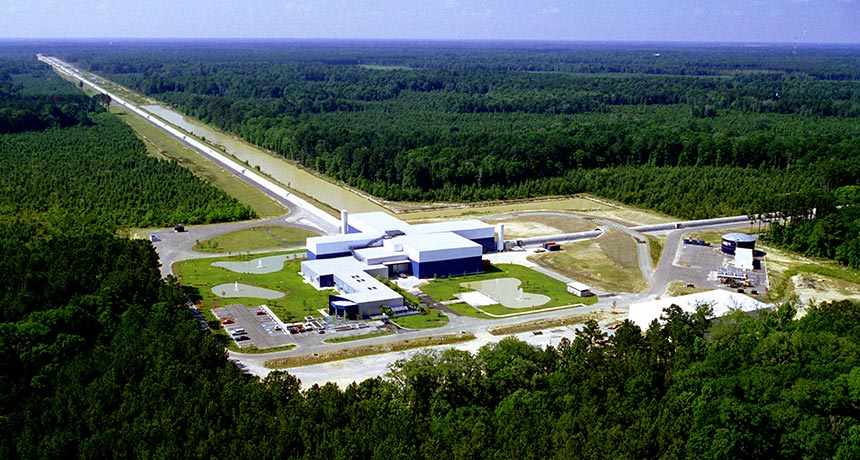Gravity waves detected at last!
Scientists finally discover gravitational waves that were predicted a century ago

Laser beams that traveled inside long tubes at Advanced LIGO in Livingston, La., (here) let scientists get their first direct look at gravitational waves.
LIGO Laboratory
By Andrew Grant
WASHINGTON, D.C. — A very special burst of waves from deep space has forever changed the way we look at the universe. These aren’t water waves or waves of light. They are gravity waves, tiny ripples produced by massive objects moving very quickly.
Two black holes produced the newly reported waves when they collided at some point roughly 1.3 billion years ago. Black holes are massive objects that trap light because their gravity is so strong.
Scientists announced the long-awaited discovery of these waves on February 11. That was a century after the famous physicist Albert Einstein first predicted gravity waves would exist. They are also describing their data in a paper published February 11 in Physical Review Letters.
“It’s the first time the universe has spoken to us through gravitational waves,” LIGO laboratory executive director David Reitze said at a press conference February 11. “As we open a new window on astronomy, we may see things we never saw before.”
Their discovery now gives scientists a new tool for studying the universe. Astronomers need these tools because not everything in the universe can be seen through a telescope. Stars, galaxies and other bright objects emit light that travels to Earth. But black holes are truly black. They don’t emit light, so telescopes can’t see them.
“Gravitational waves allow us to look at the universe not just with light but with gravity,” says Shane Larson. He’s an astrophysicist at Northwestern University in Evanston, Ill.
The discovery immediately becomes a likely candidate for a Nobel Prize. And that’s not just because it ties a neat bow around decades of evidence supporting a major prediction by Einstein. In 1916, he came up with the idea for gravitational waves, also called gravity waves. He had just introduced his famous theory of general relativity. That theory says that objects with mass will curve space, similar to how a person standing on a trampoline will bend the fabric. The bending of space changes the motion of nearby objects. For example, the sun’s mass forces Earth to orbit the star in an ellipse, not just move in a straight line.
DO THE WAVE After decades trying to directly detect the waves, the recently upgraded Laser Interferometer Gravitational-Wave Observatory, now known as Advanced LIGO, appears to have succeeded, ushering in a new era of astronomy. Science News |
Earth, the sun and other massive objects should produce gravity waves in space as they move. These waves should then spread out from the object like ripples in a pond. Objects with a lot of mass packed into a small area, such as black holes, should produce the most intense waves.
But even very intense gravity waves can be really hard to detect. They can’t be seen, heard or felt as they pass by. Physicists have needed a special observatory. The first to now pick up those waves is called the Advanced Laser Interferometer Gravitational-wave Observatory, or Advanced LIGO. This observatory consists of two detectors. One is in Livingston, La., the other in Hanford, Wash. It sensed the waves during start-up tests, four days before the upgraded observatory was due to officially begin making observations.
Each detector has two long tubes that meet at a right angle to form a giant “L.” Physicists shoot a laser beam down each tube. The beams are exactly 4 kilometers (a little less than 2.5 miles) long. When gravity waves reached the observatory on September 14, 2015, they slightly stretched one tube and squeezed the other. As a result, instead of 4 kilometers, one laser beam traveled about 3.99999999999999999999 kilometers and the other 4.00000000000000000001 kilometers.
|
|
WAVE ON Here’s the type of signal LIGO detected confirming the presence of gravity waves. Science News |
The burst of waves lasted less than a second. Scientists analyzed those waves and figured out that they came from two black holes swirling around each other. One was roughly 36 times as massive as the sun, the other about 29 times as massive. The waves got more intense as the black holes got closer. Finally, the black holes merged into one giant. Their collision happened at least 750 million light-years away. That’s a distance of some 7.1 billion trillion kilometers (4.4 billion trillion miles) from Earth. But that’s the likely minimum distance. The max? Perhaps 1.86 billion light-years away.
The size of the new black created by the merging of the two smaller ones had a mass about 62 times that of our sun. The missing three suns’ worth of mass wasn’t lost. It was transformed into energy (as Einstein had predicted in E=mc2). That energy then radiated out in all directions as gravity waves. And here’s the really amazing idea: The power output during that mass-to-energy conversion was greater than the power output, at the same time, of all of the other stars in the universe.
In the future, Advanced LIGO may capture gravity waves produced by exploding stars, called supernovas, or by pairs of neutron stars, the cores of stars that have already exploded. Black holes, neutron stars and exploding stars are some of the most extreme objects the universe has to offer.
Advanced LIGO isn’t the only system built to scout for gravity waves. A similar experiment in Italy called Advanced Virgo will join the hunt later this year. Other scientists want to conduct the search in outer space with a mission called eLISA. They are planning to launch three satellites in the 2030s that will also use lasers to detect gravity waves.







